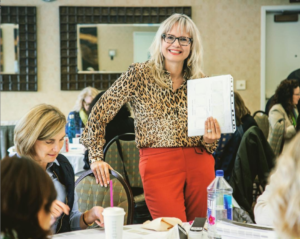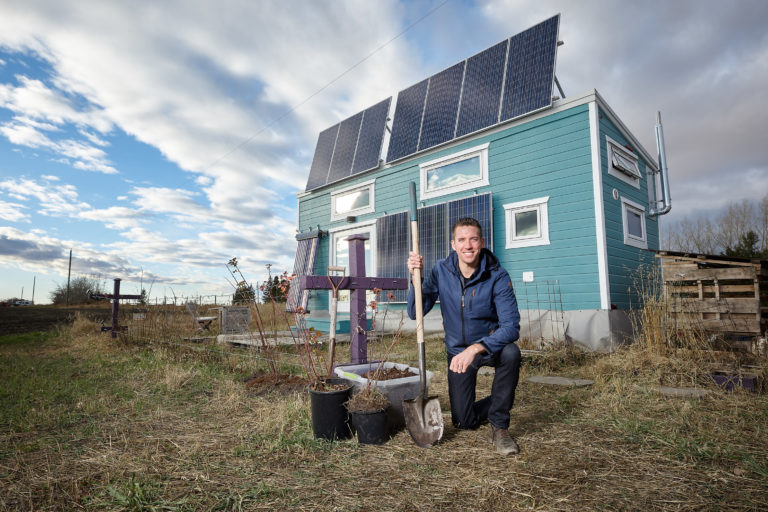 “I’ve always been obsessed with colour and the power it has to create transformation.” Maria Killam is an internationally sought-after colour expert, design blogger, author, trainer, decorator and stylist. Maria has been published in Style at Home, Canadian Living, Better Homes and Gardens and Dabble. Her work has also been featured in Apartment Therapy, HGTV and House Beautiful, among other publications.
“I’ve always been obsessed with colour and the power it has to create transformation.” Maria Killam is an internationally sought-after colour expert, design blogger, author, trainer, decorator and stylist. Maria has been published in Style at Home, Canadian Living, Better Homes and Gardens and Dabble. Her work has also been featured in Apartment Therapy, HGTV and House Beautiful, among other publications.
We asked Maria some questions about colour, and how to use it best in small spaces. For instance, we wanted to know, “What’s the biggest mistake people make when downsizing to a smaller living space?” Her answer was, surprisingly, not about colour at all. “People think they need to start with paint. My entire life is about paint and choosing the right colour for your space, and I can tell you, it’s not the right starting point. Instead, start with a few key objects, and build the space around that. For example, art. Art isn’t just valuable, it’s often very emotional for people. Choose one key piece of art, or furniture, or a special rug, or something else that makes you feel fantastic every time you look at it. Perhaps it’s something you bought, or something you inherited. It doesn’t really matter, just choose that item as a starting point, and build the room around that. Paint may be the last thing you choose – once the room is assembled, use your paint colour to flatter the objects in the room, rather than steer them.”
“You have clients all over North America. We’ve seen a trend to downsizing here in Vancouver for many years. Is this same trend in other cities?”
Maria: While my readers and clients can be anywhere, and I definitely see a huge range of homes in terms of size and type, I definitely see the trend in Vancouver is being driven by housing prices. It is ridiculously expensive to live in the city. I myself have chosen to live out in the Fraser Valley, where I can have a garden, and a quieter, and larger lot. But when you think about it, we only really use a small portion of our space on a daily basis, anyway. I mean, how often do you go into your guest room, basement, or storage area? Small is definitely the trend for reasons other than price.
“When decorating a new space, what should we look for first?”
I always say, what do you already have to work with in the space? Is there a big stone fireplace? Is it nice, or do you want to change that? Is it useful? If not, there are plenty of options. It could be anything: wood, tile, even what’s outside the window. Or, like we talked about before, it could be a key object that you already own. But start with what you’ve got there already. And of course, my entire sense of colour comes from the undertones. What are the undertones in the art, the flooring, the sourroundings? Draw from that.
“There’s an old design rule that you can’t use strong or dark colours in small spaces, because it makes them feel smaller. Is that still true, or is that thinking passé?”
There are several “old wives tales” about colour, aren’t there? Like, you can’t use blue in a north-facing room, or things like that. But, I have found a few truisms. One is that unless you’re careful, dark colours do tend to make your corners disappear. And while blue is a complicated colour, yes, you CAN use it in a north-facing room if it’s the right undertone. But here’s one rule worth remembering: dark colours recede, while bright colours come forward. Use this rule to disguise and hilight parts of the room as needed. Plus, contrasting colours can be used to add excitement. Bright vs. dark, strong vs. pale, cool vs. warm, and so on. This can make any space interesting.
“If there was one key thing you’d say can really make a space, what is it?”
I’d say it’s actually two things: lighting, and window coverings. I still like drapes, even in a small space, because they add a softness, and when they’re made properly by a professional, they can do a great job giving privacy, as well as accenting the space overall. Bring in different types of lighting, including table lamps, task lighting, overall light for the space, and all of this can be done with low-energy bulbs.
“You’ve mentioned light. What importance does light have in a smaller space?”
Look carefully at where your light comes from. (Or, if it’s not there from a window, where it should come from, if you add a lamp.) Is it bright? Cool? Warm? Consistent? This is key to how you determine colours for your space. That dining room door that opens onto your 4th floor balcony will have a HUGE impact on how you choose flooring, for example. There are also clever ways to keep the light in a room, without slapping white paint on everything. For example, you could add a mirror under a transom window, it visually expands the window, and reflects light back into the room. You could do the same with adding a painting under such a window, which expands your vision beyond the walls. NEVER neglect art in a small space!
“If our home is currently a blank slate, where do we start?”
Well, nobody’s excited about a colour that doesn’t relate to anything. You need to find a starting point, again, like an object you love, old or new. I believe if you feel like you have a blank slate, what that really means is that you’re looking for a “sign”. So, keep looking. It will find you. You need to commit, because it’s not like you can choose a paint colour, and it will be “all downhill from there”. There’s no such thing. And please, please, let me warn you of the perils of too much black or white. Everything has an undertone, and it’s especially visible in black and white. If you choose the wrong one… disaster. It’s much better to start with a bright cushion or something with bigger feelings around it.
Thank you so much Maria!! We’re also excited about your talk at the show, “10 Ways To Love Your Small Space: 5 Things to Do, and 5 Things Not to Do”. See you there!
Tickets are available for the show now, only $10 here on our website. Military and student discounts available.




